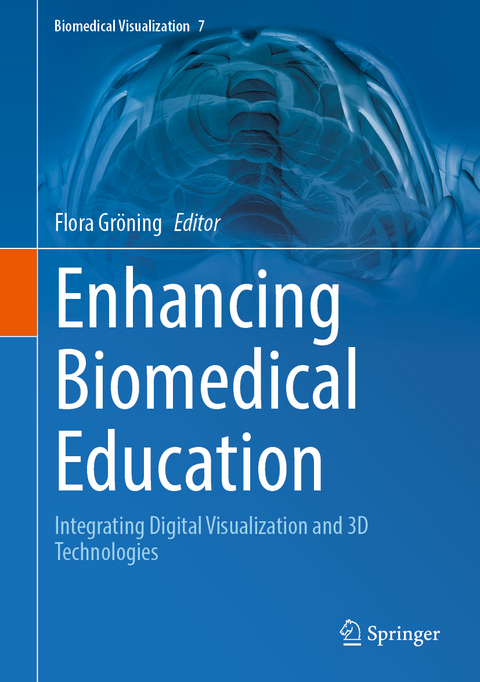
Enhancing Biomedical Education
Springer International Publishing (Verlag)
978-3-031-73269-0 (ISBN)
- Noch nicht erschienen - erscheint am 13.02.2025
- Versandkostenfrei innerhalb Deutschlands
- Auch auf Rechnung
- Verfügbarkeit in der Filiale vor Ort prüfen
- Artikel merken
This edited book explores digital visualization as a tool to communicate complex and often challenging biomedical content in an accessible and engaging way. The reader will learn how current visualization technology can be applied to a wide range of biomedical fields to benefit the learning of students and enhance the public understanding of science.
The focus of this volume will be on the innovative use of digital visualization (2D or 3D) in biomedical education and public engagement. This includes medical imaging (i.e., magnetic resonance imaging and computed tomography) as well as other digital imaging techniques such as laser scanning. It also covers the use of state-of-the-art visualization tools (i.e., augmented and virtual reality, animations and 3D printing) and the integration of 3D models of anatomical structures into serious computer games.
This book will appeal to educators, researchers and students in life science subjects as well as to healthcare professionals and designers of digital learning resources. The book will be a source of inspiration for any reader who is interested in using digital visualization as a meaningful and engaging communication tool for biomedical content, ranging from the anatomy and function of organs to the mechanisms of diseases and their prevention.
Flora Gröning is a Senior Lecturer in Anatomy and Program Director of the BSc Anatomy degree program at the University of Aberdeen. Flora also leads the development of digital 3D anatomy learning resources at her institution. She obtained her first degree (MA) in Biological Anthropology from the University of Hamburg and her PhD from the University of York for studying the mechanics of the human lower jaw using virtual 3D reconstruction and 3D mechanical modelling. Flora is also a Fellow of the Higher Education Academy. She received the University of Aberdeen’s “Best Lecturer Award 2022” for her undergraduate teaching and a “Principal’s Teaching Excellence Commendation Prize 2023” for her leadership in the creation of virtual 3D resources for anatomy education. In addition to her interest in the digital enhancement of anatomy education, Flora’s research interests include structure-function relationships in connective tissues, the development of patient-specific musculoskeletal models and the use of augmented reality headsets to guide surgeons during operations. She has widely published in these areas, has given invited keynote talks at scientific meetings and her work has been covered by several media outlets over the years. Flora has also presented her work at numerous public engagement and outreach events.
Part I. Theory and Practice.- Chapter 1. Leveraging Pedagogy: Virtual Anatomy as a Versatile Adjunct to Modern Anatomy Education.- Chapter 2. A Review of the Effectiveness and Utility of Digital Resources in Anatomical Education.- Chapter 3. Student and Educator Perceptions of Asynchronous Anatomical Education and a Digital Anatomy Learning Resource.- Chapter 4. Guided Anatomy: Embedding Magnetic Resonance Imaging in Teaching and Research at Bristol.- Chapter 5. Teaching about Ethics, Fraud and Professionalism through Imaging: Reflections and Recommendations for Practice.- Part II. Resource Development.- Chapter 6. Developing Digital Resources for Anatomy Teaching Using Structured Light Scanning Technology: A Student and Educator Opinion-based Study.- Chapter 7. Production of Human Osteological Replicas Using a Combination of Structured Light Scanning and 3D Printing Technologies.- Chapter 8. 3D-Printed Vulva: An Educational Tool for Adolescents.- Chapter 9. Canine Oncology: Investigating 3D Technology as a Visual Pre-operative and Clinical Aid for Veterinary Surgeons Treating Dogs with Hepatocellular Carcinoma.- Chapter 10. Para-Sight: An Interactive Virtual Reality Application Exploring the Infection Mechanism Employed by Plasmodium Falciparum.- Chapter 11. Kidney Exploration: A Virtual Reality Experience for Public Understanding of the Structure and Function of the Kidneys.- Chapter 12. The Holographic Brain: Interactive Holography for Engaging Young People with Anatomy Education.- Chapter 13. User Experience of a 3D Augmented Reality Human Anatomy Creative-based Learning Application.
| Erscheint lt. Verlag | 13.2.2025 |
|---|---|
| Reihe/Serie | Biomedical Visualization |
| Zusatzinfo | XIV, 378 p. 58 illus., 24 illus. in color. |
| Verlagsort | Cham |
| Sprache | englisch |
| Maße | 178 x 254 mm |
| Themenwelt | Medizin / Pharmazie ► Allgemeines / Lexika |
| Studium ► 1. Studienabschnitt (Vorklinik) ► Anatomie / Neuroanatomie | |
| Sozialwissenschaften ► Pädagogik | |
| Schlagworte | 3D modeling • 3D Printing • Anatomy Education • Anatomy Teaching • biomedical visualization • Human Anatomy |
| ISBN-10 | 3-031-73269-3 / 3031732693 |
| ISBN-13 | 978-3-031-73269-0 / 9783031732690 |
| Zustand | Neuware |
| Informationen gemäß Produktsicherheitsverordnung (GPSR) | |
| Haben Sie eine Frage zum Produkt? |
aus dem Bereich


